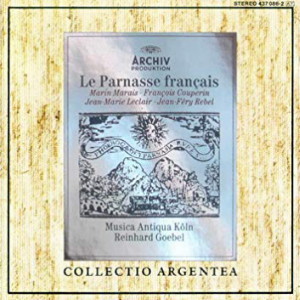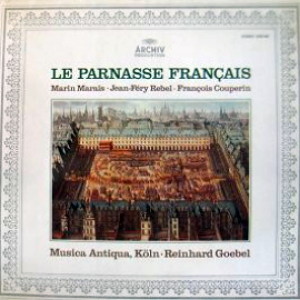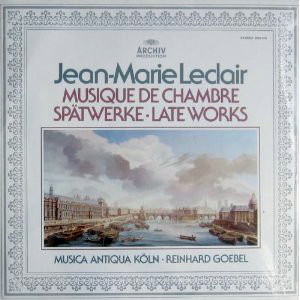 |
|
1 CD -
437 086-2 - (c) 1986
|
 |
| 1 LP -
2533 408 - (p) 1978 |
 |
| 1 LP -
2533 414 - (p) 1979 |
|
| LE PARNASSE
FRANÇAIS |
|
|
|
|
|
Marin
Marais (1656-1728)
|
|
|
| La Sonnerie de
Sainte-Geneviève du Mont de Paris
- Violon, Viole de gambe; Basse
continuo: Clavecin |
7'
50" |
|
|
|
|
| Jean-Féry
Rebel (1666-1747) |
|
|
| Tombeau de
Monsieur de Lully - Violon
I/II, Viole de gambe; Basse
continuo: Violone, Clavecin |
15'
50" |
|
| 1. Lentement -
Gravement |
3'
07" |
|
| 2. Vif - Marqué -
Gai |
1'
58" |
|
| 3. Lentement
- Doux - Récit - Grave |
3'
09" |
|
| 4. Doux - Récit -
Vivement |
4'
33" |
|
| 5. Lentement -
Gravement |
3' 03" |
|
|
|
|
| François
Couperin (1668-1733) |
|
|
| Sonate "La
Sultane" - Violon I/II,
Viole de gambe; Basse continuo:
Viole de gambe, Clavecin |
11'
42" |
|
| 1. Gravement |
4'
52" |
|
| 2. Gaiement |
1'
55" |
|
| 3. Air
(Tendrement) - Gravement |
3' 05" |
|
| 4. Légèrement -
Vivement |
1' 50" |
|
|
|
|
Marin
Marais
|
|
|
| Sonate à la
Marésienne - Violon; Basse
continuo: Viole de gambe, Clavecin |
13' 50" |
|
| 1. Un peu
grave |
1'
46" |
|
| 2. Légèrement |
1'
39" |
|
| 3. Un peu gai |
1'
36" |
|
| 4. Sarabande |
2'
26" |
|
5. Très vivement |
Gravement
|
2' 05" - 2'
06" |
|
| 6. Gigue |
2' 12" |
|
|
|
|
| Jean-Marie
Leclair (1697-1764) |
|
|
| Ouverture op.
13 no. 2 - Violon I/II;
Basse continuo: Violoncelle,
Clavecin |
13'
25" |
|
| 1. Grave - Allegro |
6'
03" |
|
| 2. Andante |
4'
50" |
|
| 3. Allegro |
2'
32" |
|
| aus Trio
en la majeur op.14 - Violon
I/II; Basse continuo:
Violoncelle, Clavecin |
|
|
| - Ouverture
(Gravement - Vivement) |
8'
50" |
|
|
|
|
| MUSICA ANTIQUA
KÖLN / Reinhard Goebel,
Direction |
|
| - Wilbert Hazelzet,
Flute traversière |
|
| - Reinhard Goebel,
Hajo Bäß, Violon |
|
- Karlheinz Steeb, Viola
|
|
| - Charles Medlam, Viole
de gambe & Violoncelle |
|
| - Jonathan Cable, Viole
de gambe & Violone |
|
| - Jaap ter Linden, Violoncelle |
|
| - Henk Bouman, Clavecin |
|
|
|
|
|
Luogo
e data di registrazione |
|
Beethoven-Saal,
Hannover (Germania) - gennaio 1978
& ottobre 1978 (Leclair) |
|
|
Registrazione:
live / studio |
|
studio |
|
|
Producer /
Engineer |
|
Andreas
Holschneider - Gerd Ploebsch /
Wolfgang Mitlehner - Klaus Scheibe
- Hans-Peter Schweigmann (Leclair) |
|
|
Prima Edizione
LP |
|
-
Archiv - 2533 408 - (1 lp) -
durata 49' 34" - (p) 1978 -
Analogico - (Le Parnasse français
- intero)
- Archiv - 2533 414 - (1 lp) -
durata 59' 24" - (p) 1979 -
Analogico - (Leclair - parziale)
|
|
|
Edizione
"Collectio" CD |
|
Archiv
- 437 086-2 - (1 cd) - durata 73'
49" - (c) 1986 - ADD |
|
|
Note |
|
- |
|
|
|
|
TREASURES
OF THE FRENCH
BAROQUE
The
last years of the life and
reign of Louis XIV (died
1715) were overshadowed by
his ill-health, numerous
deaths in the royal family,
political failures, and
famine and epidemics among
the French population. The
Roi-Soleil retired into the
everdiminishing circle of
his family. Almost every
evening in the apartments of
Madame de Maintenon he
attended a recital,
generally of chamber music,
and from time to time
concert performances were
given of scenes from operas
by Lully. The splendid and
costly productions of operas
and ballets in the inner
courtyard of Versailles, on
the Grand Canal, in the
Trianon or at Marly were
things of the past. Within
less than 30 years
Jean-Baptiste Lully had
evolved an independent
French operatic form, that
of the “tragédie lyrique”,
and he had contributed
greatly to the musical
aesthetics and style of
presentation known as the
“goût
français”,
which was to survive until
the end of the 18th century.
After Lully’s death (1687),
however, the musical
autonomy of France soon
began to be threatened: at
important concerts given
privately in Paris, e.g.
those presented by the
guitarist Médard, by the
harpsichordist and composer
Elisabeth Jacquet
de La Guerre, and by the Duc
d’Aumont - from about 1690
onwards works by Italian
composers, proscribed since
the death of Mazarin (1661),
began to be heard once more.
The young generation of
French composers - among
them François
Couperin and Jean-Féry
Rebel - were so fascinated
by such pieces that they
began to write Sonatas in
the manner of Corelli.
Nevertheless the court music
at Versailles remained
largely orientated to the
style of Lully.
Public concerts are known to
have been imitated in
Germany and Italy about the
middle of the 17th century,
but in France they
originated as late as 1725
with the founding of the
Concert Spirituel. In
addition to the foremost
figures in the musical life
of Paris, travelling
virtuosi and child prodigies
took part; their
performances, however, more
often than not served as
interludes between motets by
Delalande, Campra and Lully,
which took pride of place at
the presentations of the
Concert Spirituel until the
Revolution. This fact is
indicative of French musical
taste during the 18th
century: music was still
bound up with the “Grand Siècle”,
and there was a tendency to
reject everything considered
unduly novel and
unconventional.
The first
concertos by a French
composer appeared in 1727:
Boismortier, like Michel Corrette, an
enthusiastic exponent of
the Italian goût,
brought out 6 Concerti
for five
flutes without bass,
Corrette following in 1728
with 6 Concerti à 4,
During the same year
Blavet and Leclair played
concertos of their
own composition at the
Concert Spirituel.
Appearances are, however,
deceptive; Fontenelle’s
well known aphorism “Sonate, que
me veux-tu
- Sonata, what are you
talking about?” could also
be applied to the
concerto, because its
purpose and nature were
even more foreign to the
academic musical
understanding of the
French, for whom neither
the emotional content nor
the outward effect of the
concerto held any great
appeal.
The desire to retain
cultural autonomy was also
expressed in the concept
of the “Parnasse français”,
a monument which the
highly cultivated and
committed man of letters
Evrard Titon du Tillet
(1677-1762)
planned to erect in one of
the Paris squares in
honour of Louis XIV and of
French literature and
music. The project never
materialized, and we know
of the proposed monument
only from a bronze model,
copperplate engravings,
and above all a detailed
account of his intentions
written by Titon du Tillet
(original publication:
Paris, 1727). In this
account he gave
biographies and
appreciations of 259
French writers and
musicians who were
regarded as the élite in
their particular fields,
and who were to have been
immortalized on the
monument. These included
the composers François
Couperin, Jean-Féry
Rebel and Marin Marais.
Louis XIV as Apollo, would
have presided over the
“Parnasse français”.
·····
François
Couperin came of a family
of musicians active at the
Court of Versailles and at
the Church of St.Gervais
in Paris. He entered the
King’s service as organist
in 1693, received a title
of nobility in 1696, and
from 1701 onwards took
over to an increasing
extent the
responsibilities of the
Court harpsichordist
d’Anglebert, whose
eyesight was failing; he
later played a leading
part in the “Concerts du
Dimanche” of 1713-14, for
which he wrote his Concerts
Royaux. In 1694 he
became “Maître
de Clavecin des Enfants de
France”; his pupils
included the Dauphin
(Louis XIV’s grandson) and
his wife Marie Adelaïde,
Duchesse de Bourgogne. The
title “La Sultane” refers
to her. A contemporary
account by the Marquis de
Sourches indicates that
the Duchesse appeared in a
mask at a ball given in
1700: “The ball began in
Marly at 8 o’clock. The
Duchesse de Bourgogne was
there, enchantingly
disguised as a sultana...
Then two other sultanas
entered, then the sultan,
to the sound of a Janissary
march played by all the
instruments of the
orchestra.” This explains
-
in our opinion - what the
composer was aiming to
express when he wrote La
Sultane: the Sonata
in question was an act of
homage to the Dauphine
Marie Adelaïde,
who died in 1712. Its
introductory Gravement,
easily recognizable as a
lament, is based on the
same “sighing figure” as
the Stabat
Mater of
Agostino Steffani and the
Tombeau
de M. Meliton by
Marin Marais. In the
second movement this motif
is used as a fugue
subject. The Air
in the style of Lully -
analogous to the first
movement the duet of viols
is here contrasted by a
duet of violins - is
followed by a Gravement
in the manner of an
overture, then by a
stylized Janissary
march. A loosely-woven
fugato concludes this
work, whose composition
can be dated between 1712
and 1714.
Jean-Féry
Rebel also came of a
family of musicians active
at Court. He worked as
violinist, harpsichordist
and “batteur de mesure”
with various ensembles in
Paris and Versailles. His
oeuvre includes an opera,
two books of sonatas,
shorter vocal pieces and
numerous symphonic works.
The Tombeau
in homage to his
(presumed) teacher Lully
dates from 1695, but it
did not appear in print
until 1712/13. This work
has nothing in common with
the affections embodied in
tombeau-allemandes by
harpsichordist and
lutenist composers, or
with the free forms of the
tombeau for viols. Rather
its models are to be found
in the lamento
scenes of contemporary
operas. It contains an
abundance of
musical-rhetorical figures
and symbols, whose
succession points to a
dramatic programme.
The first movement opens
with the lamento
motif of the
descending tetrachord
which - in altered form -
twice appears as a canon
in all the parts.
Following the expression
of imploring lamentation
and mute despair there
appears at the end of the
movement, above a bass
line descending through
two octaves, a bell effect
of the two violins. The
second movement consists
principally of further
development of thematic
material introduced during
the first
movement; the descending
passage appears in all
three parts, the fugue
subject being in essence a
descending hexachord.
After a three-bar bell
motif has been heard for
the third time, a theatre
curtain seems to go up.
The Récits which
follow may be understood
as a symbol of the
lamentation of mankind.
“Baptiste!”, the first
voice (viol) seems to
exclaim, followed by the
“chorus” of the two
violins and continuo. The
Récit of the two
violins is again
accompanied by downward
scale passages of the
continuo. But it is not
only human beings who
mourn Lully’s death: in
the second Récit
the viola da gamba and the
first violin depict “fire”;
this is succeeded by the
“winds”, whose eightbar
passage takes up the lamento
motif of the first
movement. In the second
violin’s Récit,
after the broken triad
which here suggests a
motif of death, and two
exclamations of “Jean-Baptiste!”
in the first violin, the
symbol of fire turns up
again. The further course
of the music can be
interpreted as follows: an
earthquake (continuo) sets
the waters in motion. The
wind brings a temporary
lull in the turmoil, then
the earthquake becomes
more intense, the waves
more animated, the wind
again comes to the fore,
then the scene ends with an
immense earthquake. A
recapitulation of the first
movement, entitled Les
Regrets, concludes the
work.
Marin Marais was - along
with his rival Antoine
Forqueray, his junior by 16
years - the foremost master
of the viola da gamba, which
in France was not superseded
by the violoncello until
about 1740. Marais left,
apart from four operas and five
books of Pièces
de Viole,
a book of Pièces
en Trio
for flutes, oboes or violins
and continuo, and the
collection La Gamme,
published in 1723, which
contains three “morceaux de
simphonie”. In his concern
with the “goût
étranger” - the Italian
taste which was steadily
gaining ground - Marais was
not unaware, with a deep
sense of irony, of the
“affectation, contrivance,
and unnaturalness” of the
new style, which during the
regency of Philippe of Orléans
(1715-23) and then under
Louis XV (from 1723 onwards)
overshadowed the French
style. Along with the Suite
d’un
Goût
Etranger from his
fourth book of Piéces
de Viole
of 1711 33 pieces - which
are laid out in an overall
key sequence unorthodox by
classical French concepts -
the Sonate à
la
Marésienne from the
publication of 1723 is
especially noteworthy as a
product of its composer’s
concern with the features
and characteristics of
Italian musical taste.
The first two movements are
laid out in a manner
following the example of the
sonata da chiesa with the
two parts participating
almost equally in the
unfolding of the thematic
material. The next two
movements belong to the
genre of the suite: Un
peu
gai is a true corrente
of Italian provenance,
Frenchified by its tempo
indication and by the
indicated “pointer”; the Sarabande
emphasizes with its
clear-cut construction the
rhetorical element of a
“sonnate en solo”. The fifth
movement, Très
vivement,
consists of two groups of
eight eight-bar phrases. The
first half of the movement
is fashioned as a “sujet de
Basse” (here the violin
takes over the role of
accompanist), then the same
themes and key sequence are
used as “Sujet de Dessus”.
Such construction - like the
abrupt change to the
pronounced chromaticism of
the conclusion of this
movement, Gravement
- was considered to
be typical of the Italian
style. The French Gigue
which ends the work
establishes a balanced inner
structure which therefore
consists of three sonata
movements on the Italian
model and three movements
which belong to the genre of
the French suite.
A masterly example of the
art of Baroque ostinato
variation is the Sonnerie
de Sainte-Geneviève du
Mont de
Paris, in whose viola
da gamba part Marais
explored in depth the
technique of “travailler sur
un sujet”; except in a few
short phrases the “jeu cle
mélodie” is entrusted
exclusively to the violin.
Jean-Marie
Leclair “the elder” (so
called to distinguish him
from a younger brother of
the same name who was also a
violinist and composer) was
born in Lyons in 1697. The
details of his early
education are unknown, but
he later studied in Turin
with Corelli’s pupil,
Giovanni Battista Somis. He
was renowned in his lifetime
as a brilliant violinist and
composer of music for that
instrument. In an age of
Telemanns, Vivaldis and
Boismortiers - whose works
seem almost beyond counting
- Leclair is notable for the
small number of his
compositions. Between 1723
and 1753 he published his
opp. 1 to 13 in Paris. All
but one of these collections
were devoted to violin
music, and all but one of
them were engraved by his
wife and published “chez
l’auteur”. The contents of
the 13 collections - solo
sonatas, trio sonatas,
duets, concertos and the
opera Scylla
et Glaucus -
constitute virtually the
complete surviving works,
totalling fewer than one
hundred. If we consider the
size of Leclair’s œuvre,
his emphasis upon
instrumental music and his
classical formulation of a
national school of violin
playing, then his position
in French music appears
comparable to Corelli’s in
Italian music. And even in
his lifetime he had been
dubbed “the French Corelli”
(Blainville).
The Ouvertures et
Sonates en Trio, op.
13 (1753), contain three
works in each genre. The
sonatas are trio-sonata
arrangements of solo sonatas
from opp. 1 and 2. Each
“ouverture” consists of a
French overture - a slow
introduction in noble dotted
rhythms followed by a lively
section in fugal style -
with two contrasted
movements. This music
originated in the theatre.
One of the three overtures
was taken by Leclair from
his tragic opera Scylla
et Glaucus, op. 11
(1746), while the other two,
and the six additional
movements, are believed to
have been written for the
private theatre of the Duc
de Gramont in the Parisian
suburb of Puteaux. Leclair
served as “premier violon”
of the Duke’s theatre from
about 1748 until his death
in 1764.
The editor of Le Mercure
de
France, in announcing
the publication of Leclair’s
op. 13, found it to be
“equal, even superior, to
all the most esteemed things
that he has already done. We
judge the matter thus after
the strong and lively
impressions which the
performance of several
pieces from this collection
made upon us...” The Overture
no. 2 in D major
serves to confirm that
judgment. The opening
overture is in a rather
Handelian vein. The rigorous
counterpoint of this
movement is contrasted by
the following Andante, in
which a fully ornamented
cantabile melody in the
first violin completely
dominates the proceedings -
in true galant fashion. The
finale is a binary sonata
movement, based upon
minuet-like melodic
materials.
|
|